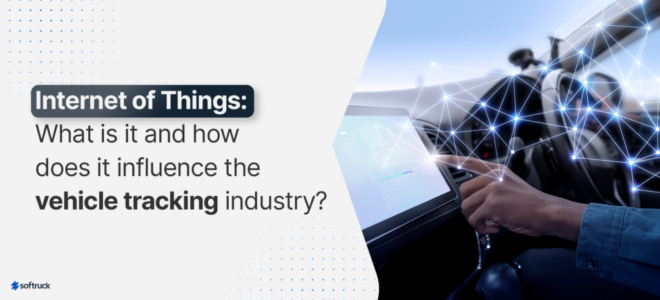Internet of Things: What is it and how does it influence the vehicle tracking industry?
La tecnología está evolucionando rápidamente, trayendo nuevas formas de optimizar procesos, aumentar la eficiencia y mejorar la seguridad en diversos sectores. Una de estas innovaciones es el Internet de las Cosas (IoT), una revolución digital que ha transformado el mercado tecnológico y ha abierto nuevas posibilidades de inversión en áreas como la seguridad electrónica y el rastreo vehicular.
El concepto de auto conectado está creciendo, y las posibilidades para el sector de rastreo son muy prometedoras, especialmente en temas de seguridad y gestión de flotas. El IoT está impactando significativamente este sector, creando nuevas oportunidades y soluciones innovadoras para proteger y gestionar vehículos de manera más eficiente.
What is the Internet of Things?
The Internet of Things (IoT) refers to the connection of physical devices to the internet, allowing them to collect and share data with each other and central systems. This technology enables everyday objects like appliances, industrial machines, and vehicles to communicate and operate autonomously or semi-autonomously, making processes smarter and more automated.
Additionally, IoT uses smart sensors and software to transmit data to a network, facilitating communication and task automation.

IoT in the vehicle tracking sector
The vehicle tracking sector is one of the most benefited by IoT. By installing smart trackers in vehicles, a wide range of data can be collected, such as real-time location, speed, driver behavior, and vehicle condition. Additionally, this data can be accessed remotely via apps or monitoring platforms, allowing companies and drivers full control over their vehicles.
IoT-connected vehicle trackers enable not only location monitoring but also vehicle usage pattern analysis, contributing to accident prevention, route optimization, and fuel savings.
Application and benefits of IoT in vehicle tracking
- Real-time monitoring: IoT enables continuous vehicle tracking, giving companies and owners the ability to follow the exact location at any time, enhancing fleet control and reducing theft risk.
- Route optimization: IoT data identifies efficient routes, saving time and fuel, crucial for logistics and transport businesses.
- Predictive maintenance: Sensors detect issues before they escalate, enabling preventive maintenance and extending vehicle life.
- Vehicle safety: Alerts for reckless behavior, and quick vehicle recovery in theft cases.
- Cost reduction: Optimized routes and predictive maintenance lower operational costs.
- Enhanced customer experience: Real-time tracking improves communication and efficiency.
Trends of IoT in Vehicle Tracking for the Future
The future of vehicle tracking with IoT promises significant technological innovations that go beyond current solutions. Here are some of the main trends:
- Integration with Artificial Intelligence (AI): The combination of IoT with AI will allow for deeper analysis of the data collected by vehicle sensors, providing predictions of failures and behavior patterns. This integration is already being utilized to improve efficiency and reduce operational costs, as well as enhance process automation and optimized routes.
- Advanced Predictive Maintenance: Telemetry sensors will continue to evolve, allowing fleet managers to not only identify problems but also predict more accurately when vehicles will need maintenance. This will ensure greater vehicle availability and reduce unplanned downtime.
- Energy Efficiency: IoT solutions are increasingly focused on sustainability. Future technologies aim not only to optimize fuel consumption but also to reduce the environmental impact of fleets by incorporating more eco-friendly and efficient practices.
- Edge Computing: Another important trend is the use of edge computing, which processes data closer to the source, reducing latency and improving real-time response capability. This technology will be essential for managing the large volume of data generated by connected vehicles.
- 5G Connectivity: The advancement of 5G will drive the adoption of IoT in the vehicle tracking sector, enabling greater connectivity and faster, more reliable data transmission, essential for autonomous vehicle systems and other applications that rely on real-time communication.
Conclusion
In conclusion, the Internet of Things (IoT) is shaping the future of vehicle tracking, bringing innovations that go beyond basic connectivity. With the advancement of technologies such as Artificial Intelligence, predictive maintenance, energy efficiency, and 5G connectivity, the tracking sector will become increasingly intelligent and sustainable. These innovations not only enhance the safety and efficiency of fleets but also open new possibilities for resource optimization and cost reduction. The future of vehicle tracking, driven by IoT, promises to transform how vehicles are managed, making the process more automated, sustainable, and connected.

